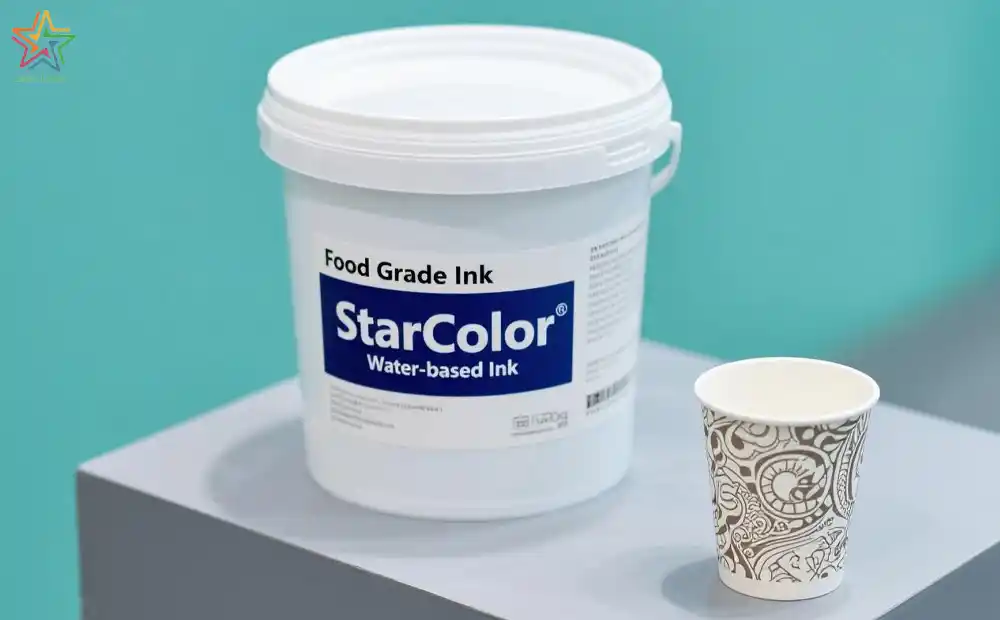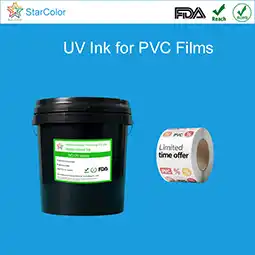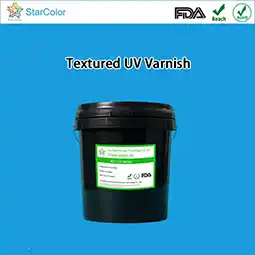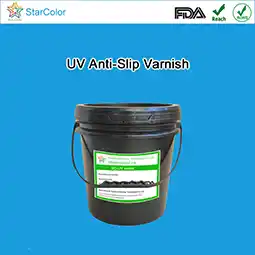Can Water Based Ink for Flexo Printing Be Optimized for High-Line Anilox Rolls?
Date: Aug 04 2025 From: Star Color Views:
I. Why Do High-Line Anilox Rollers "Be Picky" About Inks?
As the "ink volume distribution core" of flexography, the line count and cell structure of anilox rollers directly determine the ink transfer effect. The characteristics of high-line anilox rollers (such as 600-line, 800-line, 1000-line) and their requirements for inks are as follows:1. "Precisionism" of Cell Structure
- Smaller and Deeper Cells: The volume of a single cell of a 600-line anilox roller is approximately 2-4 BCM (billion cubic microns), only 1/5-1/8 of that of a 300-line anilox roller. This requires the ink to accurately fill the tiny cells without clogging;
- Narrow Opening and Thin Wall: The opening width of the cell is usually less than 30μm. If the ink particle diameter exceeds 10μm, it is easy to get stuck at the edge of the cell and form ink accumulation, leading to "broken lines" and "white spots" in the printed pattern.
2. "Strict Conditions" for Ink Transfer
High-line anilox rollers have higher linear speeds (usually >300 meters per minute), requiring inks to have:
- Low Viscosity Fluidity: Able to quickly fill cells and transfer evenly to the plate under high-speed rotation;
- Rapid Drying Property: The ink layer of fine patterns is thin (usually <1μm), requiring quick drying in a short time to avoid smudging;
- Shear Resistance Stability: Not easy to demulsify and stratify under high-speed shear, otherwise it will cause color deviation.
Traditional water-based flexo inks often have three major problems on high-line anilox rollers due to large pigment particle size (>15μm) and high viscosity (>50cps): "plate clogging, insufficient ink volume, and blurred patterns", which is the root cause of industry doubts about their adaptability.

II. 3 Major Technical Breakthroughs in Adapting Water-Based Flexo Inks to High-Line Anilox Rollers
With the upgrading of formula technology, the new generation of water-based flexo inks has achieved stable adaptation to high-line anilox rollers, with core breakthroughs focusing on the following three aspects:1. Nano-Level Pigment Grinding Technology: Solving the "Plate Clogging" Problem
By adopting the combined process of "sand mill + ultrasonic dispersion", the pigment particle size is controlled at 3-5μm (90% of particles <8μm), which is much smaller than the cell opening width of 600-line anilox rollers. For example, a brand of food-grade water-based ink, tested by a laser particle size analyzer, has a titanium dioxide pigment particle size D50=4.2μm and carbon black pigment D50=3.8μm. It can print continuously on an 800-line anilox roller for 8 hours without plate clogging, and the anilox roller cleaning cycle is extended from 2 hours to 12 hours.
At the same time, by adding "anti-settling additives", the pigment settlement rate of the ink after standing for 24 hours is <1%, avoiding cell clogging caused by pigment settlement.
2. Low Viscosity and High Stability Formula: Achieving "Uniform Transfer"
The new generation of water-based flexo inks adjusts the resin system (such as using modified acrylate) to control the viscosity at 15-30cps (25℃, Brookfield viscometer) while ensuring color concentration, with a viscosity change rate <10% under high-speed shear. Comparative data shows:
- Traditional ink (viscosity 60cps) has an ink volume deviation rate of ±8% on 600-line anilox rollers;
- Low viscosity formula ink (viscosity 25cps) reduces the ink volume deviation rate to ±3%, and the pattern edge clarity is improved by 40%.
3. Rapid Cross-Linking Drying System: Adapting to "High-Speed Production"
In response to the drying needs of fine ink layers, by introducing "low-temperature catalytic cross-linking" technology, the ink can be dried at 40-60℃, with surface drying time <1 second and complete drying time <3 seconds. A soft packaging enterprise's actual measurement shows that when using an 800-line anilox roller + low viscosity water-based ink, the printing speed reaches 350 meters per minute, and there is no smudging after rewinding, saving 30% of drying energy consumption compared with traditional processes.
III. Matching Formula Between Water-Based Flexo Inks and High-Line Anilox Rollers
Adaptation is not simply "replacing ink", but requires establishing a linkage plan of "anilox roller line count - ink parameters - printing scenario":1. Select Ink Parameters by Anilox Roller Line Count
| Anilox Roller Line Count (Lines/Inch) | Recommended Pigment Particle Size (μm) | Ink Viscosity (cps) | Solid Content (%) | Application Scenarios |
| 600 | 3-5 | 25-35 | 35-40 | Food labels, flexible packaging fine patterns |
| 800 | 2-4 | 18-25 | 30-35 | Cosmetic packaging, membrane switches |
| 1000+ | <3 | 15-20 | 25-30 | Anti-counterfeiting labels, high-definition graphics and text |
2. Key Process Parameter Adjustments
- Doctor Blade Angle: Adjust from the traditional 45° to 50-55° to reduce scratching on the cells and avoid excessive ink scraping;
- Anilox Roller Cleaning: Use a combination of "ultrasonic + special cleaning agent", clean after daily production, and perform in-depth maintenance weekly;
- pH Value Control: Keep the ink pH value at 8.0-8.5 (alkaline environment) to prevent resin precipitation from clogging cells.
3. Immediate Solutions to Common Problems
- Insufficient Ink Volume: Check if the viscosity is too high (can be adjusted by adding 5-10% deionized water) or if the anilox roller is clogged (stop the machine immediately for cleaning);
- Pattern Blooming: It may be that the ink's shear resistance is insufficient, and a high-stability formula needs to be replaced;
- Poor Drying: Appropriately increase the drying temperature (not exceeding 60℃ to avoid substrate deformation) or reduce the printing speed by 5-10%.
IV. Case Verification: Successful Adaptation Experience of 3 Enterprises
1. Food Label Printing Factory: 600-Line Anilox Roller Achieves "Seamless Plate" PrintingAn enterprise upgraded the anilox roller from 400-line to 600-line to improve the LOGO clarity of mineral water labels. Initially, frequent plate clogging occurred when using traditional water-based inks. After replacing with nano-level water-based inks:
- The printing speed remained at 300 meters per minute, and the daily output increased by 20%;
- The LOGO edge clarity was improved by 50%, and the customer complaint rate dropped from 12% to 2%;
- The monthly anilox roller cleaning cost was saved by approximately $1,100.
2. Flexible Packaging Enterprise: 800-Line Anilox Roller Solves the "Gradient Pattern" Problem
The enterprise undertook a snack packaging order requiring gradient color pattern printing, and the original 300-line anilox roller could not present a delicate transition. After adopting 800-line anilox roller + low viscosity water-based ink:
- The gradient layers increased from 5 levels to 10 levels, with a color reproduction rate of 95%;
- Ink consumption was reduced by 15% (due to thinner ink layers), saving $1,600 in monthly raw material costs;
- Passed the strict appearance inspection standards of the brand and became a core supplier.
3. Pharmaceutical Packaging Factory: 1000-Line Anilox Roller Meets "Micro Text" Printing Requirements
Pharmaceutical packaging requires printing "batch numbers, validity periods" and other micro texts (font size <1.5pt), which are easily blurred with traditional processes. After adapting to special water-based inks:
- The clarity of micro texts passed the 20x magnifying glass inspection with a 100% qualification rate;
- Complied with USP Class VI pharmaceutical standards with no migration risk;
- Production efficiency was 3 times higher than that of offset printing process, and the order change time was shortened to 30 minutes.
V. Conclusion: The Core of Adaptation is "Technical Synergy", Not "Material Limitation"
The answer to whether water-based flexo inks can adapt to high-line anilox rollers is clear: Stable adaptation can be completely achieved through nano-level grinding, low viscosity formulas, and process optimization, while taking into account environmental protection (VOC emissions <50g/L) and cost advantages (15-20% savings compared to solvent-based inks).The key is to avoid "blindly upgrading equipment" or "simply replacing inks", but to establish a systematic matching thinking of "anilox roller - ink - process". It is recommended that enterprises before upgrading:
- Test the particle size distribution and viscosity stability of existing inks;
- Select the appropriate anilox roller line count according to the printing scenario (not the higher the better);
- Cooperate with ink suppliers for small-batch test printing and optimize parameters before mass production.
If you need to test inks adapted to specific line count anilox rollers, you can [apply for free samples and technical support], and the professional team will provide customized matching solutions. In the trend of high-precision flexography, the synergy between water-based inks and high-line anilox rollers will become the core competitiveness for enterprises to reduce costs and increase efficiency.
 RU
RU EN
EN CN
CN















